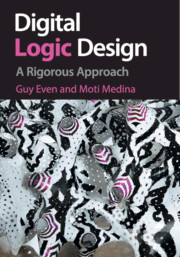Book contents
- Frontmatter
- Contents
- List of Algorithms
- Preface
- PART I PRELIMINARIES
- 1 Sets and Functions
- 2 Induction and Recursion
- 3 Sequences and Series
- 4 Directed Graphs
- 5 Binary Representation
- 6 Propositional Logic
- 7 Asymptotics
- 8* Computer Stories: Big Endian versus Little Endian
- PART II COMBINATIONAL CIRCUITS
- PART III SYNCHRONOUS CIRCUITS
- PART IV A SIMPLIFIED DLX
- Bibliography
- Index
6 - Propositional Logic
from PART I - PRELIMINARIES
Published online by Cambridge University Press: 05 November 2012
- Frontmatter
- Contents
- List of Algorithms
- Preface
- PART I PRELIMINARIES
- 1 Sets and Functions
- 2 Induction and Recursion
- 3 Sequences and Series
- 4 Directed Graphs
- 5 Binary Representation
- 6 Propositional Logic
- 7 Asymptotics
- 8* Computer Stories: Big Endian versus Little Endian
- PART II COMBINATIONAL CIRCUITS
- PART III SYNCHRONOUS CIRCUITS
- PART IV A SIMPLIFIED DLX
- Bibliography
- Index
Summary
In this chapter, we turn to a topic in mathematical logic called propositional logic. Propositional logic is a key tool in logical reasoning and is used to understand and even generate precise proofs. Our attraction to propositional logic is ignited by the ability to represent Boolean functions by Boolean formulas. Some Boolean functions can be represented by short Boolean formulas, thus offering a concise and precise way to describe Boolean functions.
BOOLEAN FORMULAS
Building Blocks. The building blocks of a Boolean formula are constants, variables, and connectives.
A constant is either 0 or 1. As in the case of bits, we interpret a 1 as “true” and a 0 as “false.” The terms constant and bit are synonyms; the term bit is used in Boolean functions and in circuits, while the term constants is used in Boolean formulas.
A variable is an element in a set of variables. We denote the set of variables by U. The set U does not contain constants. Variables are usually denoted by uppercase letters.
Connectives are used to build longer formulas from shorter ones. We denote the set of connectives by C. We consider unary, binary, and higher arity connectives.
(a) There is only one unary connective called negation. Negation of a variable A is denoted by not(A), A, or Ā.
(b) There are several binary connectives; the most common are and (denoted also by ∧ or ·) and or (denoted also by ∨ or +).
- Type
- Chapter
- Information
- Digital Logic DesignA Rigorous Approach, pp. 68 - 93Publisher: Cambridge University PressPrint publication year: 2012



